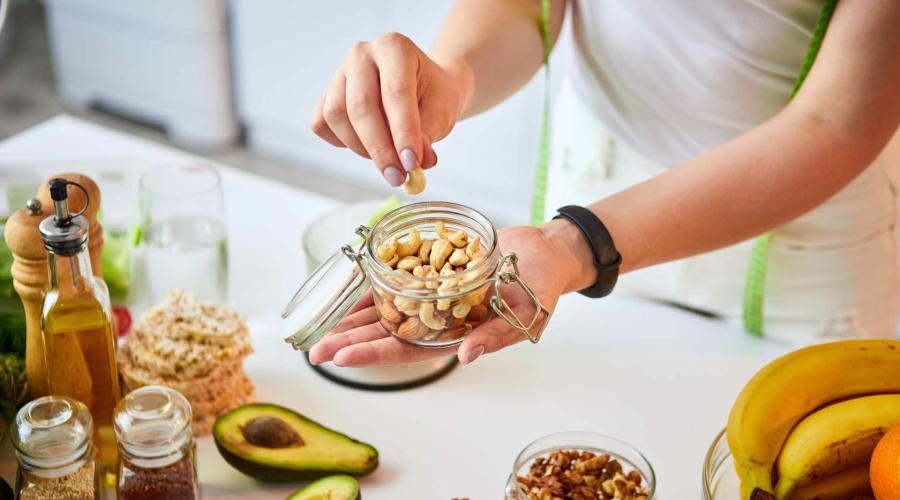
With a quick Internet search, you’ll find countless websites promoting the Whole30 diet. The Whole30 brand claims that millions have seen “life-changing” results.1 Is it really all it’s hyped up to be? And more importantly, should you try it?
In this post, we’ll review the Whole30 diet – and give you our take on it from a dietician's perspective. This includes what it is, how to follow it safely and additional information about difficulty and supplementation.
We hope this post empowers you to make individualized dietary decisions alongside your healthcare provider.
Read More: Understanding Diet Fads Through The Decades
What Is the Whole30 Diet?
Whole30 is an elimination diet. It eliminates several types of foods, including dairy, grains, legumes, alcohol and sugar.2
Many people try the Whole30 diet for weight loss. However, Whole30 is marketed as a way to decrease inflammation and unpleasant symptoms like cravings, fatigue, anxiety, GI issues, skin issues and more.1
According to the American Heart Association (AHA), diets like Whole30 do not meet AHA’s science-based criteria for a sustainable healthy eating pattern.3 So, in that sense, it is a fad diet.
Furthermore, it can be very hard to find information that comes from trusted sources like the Academy of Nutrition and Dietetics, AHA and other reputable health organizations – probably because the Whole30 diet is not based on solid scientific evidence. That being said, you will find tons of content from dieters and the Whole30 brand itself, which encourages purchasing their products.
Read More: What’s Missing From Your Diet?
How to Follow a Whole30 Diet (Safely)
Whole30 should be temporary. This is not a diet that should be continued over the course of months or years. Doing so may put you at risk of nutrient deficiencies and an overall unhealthy relationship with food. (More on that later!) If you choose to try the Whole30 diet, notify your doctor or Registered Dietitian so you can be monitored for nutrient deficiencies.
Whole30 was originally created as a way to identify problematic foods that cause unpleasant symptoms (e.g., bloating, cravings, fatigue) in individuals. It’s also been experimented with for weight loss. Whole30 is meant to be a 30-day elimination diet and a 10+ day reintroduction period. Here is a simple step-by-step for Whole30:
- Eliminate all off-limit foods for 30 days.
- After 30 days, reintroduce 1 off-limit food/food group at a time.
- See if you have any unpleasant symptoms. If you do have symptoms, that food may be the cause of your issues. Stop eating that food.
- Go back to the elimination diet for at least 2 days for a reset.
- After your reset, reintroduce a new food and monitor for symptoms.
If you mess up or have a cheat day during this process, start over from the very beginning.
The end-goal is to create a plan that includes all the foods you can tolerate. Once you create this plan, you’ll know what you can eat “forever.”4
What Foods to Avoid on a Whole30 Diet
According to the Whole30 brand, you’ll have to eliminate the following foods for 30 days. After 30 days, you can start to reintroduce some of these foods back into your diet.4
Foods to avoid on Whole30 (not a complete list):
- Sugar and sweeteners (honey, table sugar, maple syrup, stevia)
- Alcohol (for drinking and cooking)
- Grains (wheat, barley, rye, oats, rice, corn, cereal, sprouted grains and gluten-free varieties)
- Legumes (beans, peanuts, soy, lentils)
- Animal-based dairy (milk, yogurt, cheese, kefir, sour cream, ice cream)
- Carrageenan, sulfites, MSG
- Commercially prepared snack foods
- Food that makes you feel out of control /li>
- Food that causes intense cravings
- Gluten-containing foods and ingredients
Do not eat these foods, and do not eat them if they are present in an ingredient list on a food label.
The diet also discourages healthy recreation of treats. So, you can’t make “healthy” pancakes or muffins, even if you use approved ingredients. According to Whole30, recreating these treats will not actually reduce cravings for the real thing.4
What Foods to Eat on a Whole30 Diet
Wondering what foods you can eat on Whole30? Here are some approved foods:2,4
- Fruits
- Vegetables
- Nuts (excludes peanuts)
- Meat, seafood and eggs
- “Natural fats” (ghee, clarified butter, plant oils, beef tallow)
- Herbs and spices
- 100% fruit juice
- Green beans and peas (sugar snap, snow peas)
- Vinegars
- Alcohol-based extracts (almond, vanilla)
- Coconut aminos (coconut nectar, coconut syrup)
- Iodized salt
The diet encourages eating foods with a short and “recognizable” ingredients list. Or, those that are completely unpackaged and unprocessed.4
Related: 12 Months Of Healthy Eating: Plant-Based Meals
Whole30 Diet FAQs
We’ll answer some commonly asked questions about the Whole30 diet so that you can better determine if it’s right for you.
What Are the Benefits of the Whole30 Diet?
There are some benefits to the Whole30 diet, such as:
- Part of a community: Whole30 has a robust online community. Between recipes, meal plans and support groups, this can make following the diet much easier than doing it on your own.2
- Fairly clear guidelines: Many people like to follow diets with clear-cut rules to help them stay on track. Compared to other diets, Whole30 has plenty of structure.
- Increased consumption of fruits and vegetables: Many Americans do not eat enough fruits and vegetables. Following the Whole30 diet may encourage people to eat more of them.
- Decreased consumption of sugar and alcohol: According to the CDC, it is recommended that women consume 0-1 drinks per day and men consume 0-2 drinks per day (on days alcohol is consumed).5 The CDC also recommends limiting added sugar to less than 10% of your daily calorie intake.6
Is it Hard to Follow a Whole30 Diet?
Compared to other diets, Whole30 is a mixed bag when it comes to difficulty. On one hand, you might appreciate the strict program rules (or not). On the other hand, this diet eliminates many different foods. Figuring out how to plan your meals can be challenging without support.
Are There Safety Concerns with the Whole30 Diet?
Prior to starting a new diet, consult your doctor and/or dietitian. Depending on your individual health profile and use of medications, certain diets can put you at risk for nutrient deficiencies, worsening of health status, and/or adverse drug-nutrient interactions.
Let’s talk about safety concerns for the Whole30 diet:
- Lack of substantial evidence: While Whole30 makes certain claims in its content and marketing materials, reliable scientific evidence is lacking in support of its guidelines. However, Whole30 is an elimination diet, and various elimination diets have been used for medical evaluation and intervention for years.
- Potential for disordered eating: The Whole30 diet requires food restriction, label reading and food awareness.
- Lack of support, especially during setbacks: No matter what diet you follow, you will have mess-ups. Whole30 has zero tolerance for mistakes – even if it’s just for one day. While the elimination phase is “only 30 days,” if you have to keep restarting, you could be in the elimination phase for months.2,4
- Potential for unnecessary food restriction: Unpleasant symptoms like skin reactions, fatigue and inflammation may not be food-related. Talk to your medical team about your symptoms first and never delay seeking medical treatment because of something you have read on the internet.
- Based on anecdotal evidence: Whole30 was initially based on the founder’s personal experience. Personal experience cannot reliably be translated for the greater population and personal experience is not reliable scientific evidence. Also, some guidelines simply do not align with established healthy eating practices.
Do I Need to Take Supplements on a Whole30 Diet?
In most cases, it is best to obtain nutrients from food sources first. Supplements can be used to fill in nutritional gaps, meet specific nutrient needs and/or when one’s diet lacks certain nutrients.
Remember to consult with your doctor before starting or changing your supplement regimen. Supplements can play a part in your health status and how certain medications work.
If you decide to follow Whole30 long-term, and do not take any nutritional supplements, you may be at risk of several nutrient deficiencies, including:2
- Calcium
- Vitamin D
- B vitamins
- Folate
When you’re deficient, supplementation and/or dietary changes may be required. Supplementation should be discussed and analyzed by a healthcare provider prior to starting.
Related: What Foods Contain Ubiquinol?
In Summary
Whole30 can be described as a fad diet, and it’s meant to be temporary. Whole30 is also a for-profit brand, which is fine – just be aware there’s a profit motivation.
Many people enjoy the challenge of achieving a goal they set for themselves. However, if your goal is to find a long-term dietary eating pattern that is sustainable, flexible and balanced, look elsewhere.
If you decide to try Whole30, do so alongside a Registered Dietitian. Because of its highly restrictive nature, strict guidelines and good/bad food labeling, those with disordered eating and eating disorders should not engage in this diet.
References
1 Whole30 brand. Whole30. Whole30 Website. Accessed March 8, 2023.
2 Levi A. The Whole30 diet: The cons - and the main pro. Health Website. Updated November 7, 2022. Accessed May 11, 2023.
3 American Heart Association (AHA). What is the Mediterranean diet? AHA Website. Published January 9, 2020. Accessed March 8, 2023.
4 Whole30. Plan for Whole30 success. Whole30 Website. Accessed March 8, 2023.
5 Centers for Disease Control and Prevention (CDC). Dietary guidelines for alcohol. CDC Website. Published April 19, 2022. Accessed February 6, 2023.
6 CDC. Get the facts: Added sugars. CDC Website. Accessed March 8, 2023.












